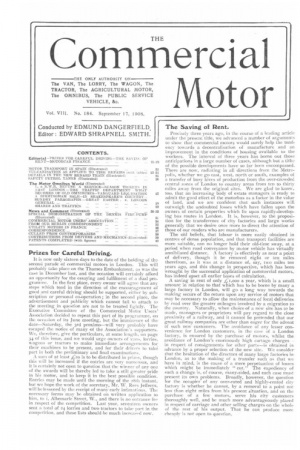The Saving of Rent.
Page 1

If you've noticed an error in this article please click here to report it so we can fix it.
Precisely three years ago, in the course of a leading article under the present title, we advanced a number of arguments to show that commercial motors would surely help the tendency towards a decentralisation of manufacture and an improvement in the conditions of housing available to the workers. The interval of three years has borne out those anticipations in a large number of cases, although but a tithe of the possible developments have so far been encompassed. There are now, radiating in all 'directions from the Metropolis, whether we go east, west, north or south, examples of a transfer of busy hives of production from the over-Crowded central zones of London to country areas from ten to thirty miles away from the original sites. We are glad to know, too, that an increasing body of estate managers is ready to admit the good effect of the motorbus as a factor in the value of land, and we are confident that such instances will outweigh the undoubted losses which have fallen upon the, owners of certain properties which lie upon rapidly-developing bus routes in London. It is, however, to the proposi-. tion for the transference of city factories and large works generally that we desire once more to direct the attention of those of our readers who are manufacturers.
The old beliefs, that labour is more easily obtained in. centres of dense population, and that transport facilities are more suitable, can no longer hold their old-time sway, at a. period when road conveyance by motor vehicle has virtually annihilated distance. A factory, is effectively as near a point of delivery, though it be removed eight or ten miles. therefrom, as it was at a distance of, say, two miles ten years ago, and this change in perspective, which has been wrought by the successful application of commercial motors, has indeed upset all earlier bases of calculation.
A saving in rent of only ;61,000 a year, which is a smalL amount in relation to that which has to be borne by Many a large factory in London, will go a long way towards the making secure of the return upon any Service of motors that may be necessary to allow the maintenance of local deliveries. by road over the greater mileages involved by a migration to the country. Naturally, when choice of a new site has to be made, managers or proprietors will pay regard to the close• proximity of a railway, and it cannot be pretended that our great railway companies are other than eager for the advent of such new customers. The avoidance of any lesser convenience for London customers, in the case of a London factory, is ensured by the purchase of motors, whilst the avoidance of London's enormously high cartage charges• in respect of consignments for other parts—is obtained in advance by a proper selection of the new site. We considerthat the hesitation of the directors of many large factories in London, as to the making of a transfer such as that we have in mind, is the cause of a mere perpetuation of losses which might be immediately "cut." The expediency of such a change is, of course, many-sided, and each case must present its own problems. Broadly, however, the question for the occupier of any over-rated and highly-rented city factory is whether he cannot, by a removal to a point riot less than eight miles from his present situation, and on the purchase of a few motors, serve his city customers thoroughly well, and he much more advantageously placed in respect of carriage and other selling charges on the whole of the rest of his output. That he can produce more cheaply is not open to question.




















